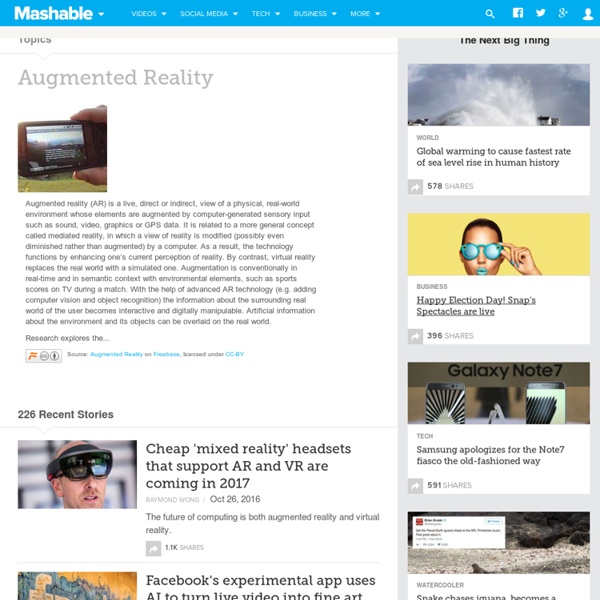



http://mashable.com/category/augmented-reality/
The next big thing in tech: Augmented reality - CNET SANTA CLARA, Calif. -- Reality isn't what is used to be. With increasingly powerful technologies, the human universe is being reimagined way beyond Google Glass' photo-tapping and info cards floating in space above your eye. The future is fashionable eyewear, contact lenses or even bionic eyes with immersive 3D displays, conjuring up a digital layer to "augment" reality, enabling entire new classes of applications and user experiences. Like most technologies that eventually reach a mass market, augmented reality, or AR, has been gestating in university labs, as well as small companies focused on gaming and vertical applications, for nearly half a century. Emerging products like Google Glass and Oculus Rift's 3D virtual reality headset for immersive gaming are drawing attention to what could now be termed the "wearable revolution," but they barely scratch the surface of what's to come.
How Augmented Reality Works Video games have been entertaining us for nearly 30 years, ever since Pong was introduced to arcades in the early 1970s. Computer graphics have become much more sophisticated since then, and game graphics are pushing the barriers of photorealism. Now, researchers and engineers are pulling graphics out of your television screen or computer display and integrating them into real-world environments. Pokémon Go Brings Augmented Reality to a Mass Audience Pokémon, a hybrid of the words “pocket” and “monsters,” belongs to the Pokémon Company, which is partly owned by Nintendo, the Japanese game pioneer, which has struggled to adapt to the era of gaming on mobile devices like smartphones and tablets. In the cartoon, Pokémon trainers use characters to battle each other for sport. The uptake of Pokémon Go, which is so far available only in the United States, Australia and New Zealand, has been so furious that it sent Nintendo’s market capitalization soaring $9 billion in the last few days. Pokémon Go, though, is actually the work of a start-up, Niantic Inc., which was created inside Google and spun out of the company last year. Niantic’s first game, a science-fiction conspiracy thriller called Ingress, was made possible by Google’s digital mapping service. About 15 million users have downloaded Ingress, and there are a little over one million active players a month, said John Hanke, Niantic’s chief executive.
LED Lights Make Augmented Vision a Reality LED Lights Make Augmented Vision a Reality Okay, this is just freaky. We know LED lights are versatile enough to be used for practically anything, but LED contact lenses? Really?! Yes, as it turns out, really. Augmented reality NASA X38 display showing video map overlays including runways and obstacles during flight test in 2000. Augmented reality (AR) is a live direct or indirect view of a physical, real-world environment whose elements are augmented (or supplemented) by computer-generated sensory input such as sound, video, graphics or GPS data. It is related to a more general concept called mediated reality, in which a view of reality is modified (possibly even diminished rather than augmented) by a computer.
Android-powered Google Glasses: The augmented reality HUD dream is coming It’s about time: By the end of 2012, Google will launch a pair of Android-powered, augmented reality, head-up display (HUD) glasses. Anonymous Google employees, speaking to The New York Times, say that the glasses will resemble a pair of Oakley Thumps (pictured above), will have 3G or 4G connectivity, a forward-facing camera, GPS, and a full array of movement sensors. They will cost “around the price of current smartphones.” Unlike Google’s upcoming home entertainment system, a pair of wearable Google Glasses makes an awful lot of sense.
What is augmented reality (AR)? - Definition from WhatIs.com Augmented reality is the integration of digital information with the user's environment in real time. Unlike virtual reality, which creates a totally artificial environment, augmented reality uses the existing environment and overlays new information on top of it. Boeing researcher Thomas Caudell coined the term augmented reality in 1990, to describe how the head-mounted displays that electricians used when assembling complicated wiring harnesses worked. One of the first commercial applications of AR technology was the yellow "first down" line that began appearing in televised football games sometime in 1998. Today, Google glass and heads-up displays in car windshields are perhaps the most well-known consumer AR products, but the technology is used in many industries including healthcare, public safety, gas and oil, tourism and marketing. Learn how augmented reality is being used by phlebotomists:
Augmented Awareness & Reality Games, ARE2012 ARE2012 is being live streamed this year, and the wrap up fire side chat between Bruce Sterling and Daniel Suarez and a surprise stupid fun grand finale is still to come. We have a live stream this year so you can see for yourself! Also you can catch up on any sessions you have missed, including the video of my talk, Augmented Awareness and Reality Games. My slides are here and my speaker notes are below, enjoy! 1. Hi my name is Tish Shute.
What is Augmented Reality? Webopedia Definition Main » TERM » A » By Vangie Beal Abbreviated as AR, Augmented Reality is a type of virtual reality that aims to duplicate the world's environment in a computer.